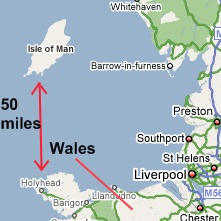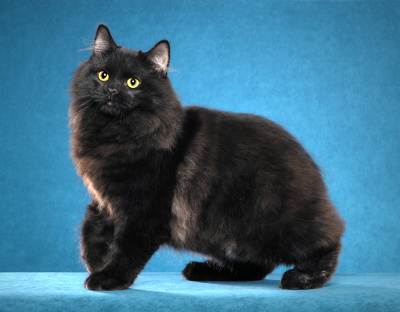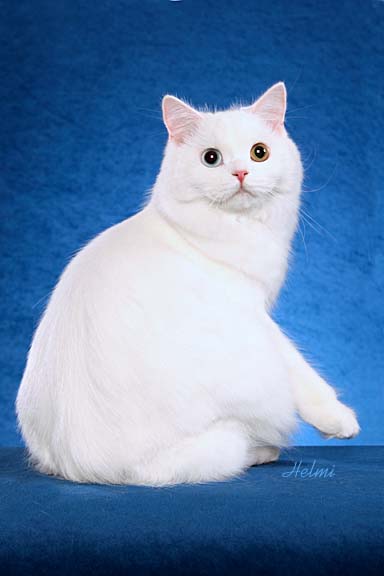
Introduction
The Cymric cat has some interesting things about it that are immediately of note. To some it is not a different cat breed but a long haired version of another breed, the Manx. This calls into question what you call a “different cat breed” and once you go down that road it’ll be some time before you come back.
The second thing is the name of the cat. Some websites say that this breed is named after the Gaelic word for Wales. This seems to be incorrect. But it is said that the name comes from the word, “Cymru”, which is the Welsh word for Wales1.

It is also thought that the Cymric Cat was named after Wales because this long haired version of the Manx was seen there some time ago. This seems likely as the north coast of Wales in about 50-70 miles south of the Isle of Man, the original home of the Manx Cat (see map).
Cymraeg (Cymric) is spoken in what the English call Wales. It’s part of the Brythonic branch of insular Celtic, along with Cornish and Breton. Cymric is used quite extensively in Wales still and the language is being kept alive.
The English say that the people of Wales speak Welsh, but the word “Welsh” in Gaelic is Cymric. It would seem the name was made up on the basis of its ancestory and the various factors referred to.
Interestingly when you do a Google search for “Cymric” none of the listings (at least the early ones) refer to the language of Wales but to the cat.

History
I am not going to recite the history of the Cymric Cat as it will be the same as the Manx Cat except for the introduction of the medium-long double coat, which is where its history parts from the Manx. This is a North American cat of Welsh ancestory1 that originates from the 1960s.
How did this breed acquire the medium-long coat? One theory is that the Cymric was mated with a Norwegian Forest Cat that was imported into the Isle of Man by the King of Norway. This has the air of legend or myth to me and the history of domestic cat breeds is littered with myths and legends.
It seems that Manx cats “have always produced the occasional longhaired kittens..”1 The long coat was developed, therefore, through deliberate selective breeding.
The story is that the Cymric Cat breed was started in Canada in the 1960s (implying human intervention). This view is supported by the authors of Robinson’s Genetics for Cat Breeders and Veterinarians. Click on the following link to see how the creation of this breed fits in with cat history presented as a time line.

Appearance/Character/Rarity
The Cymric can be shown in all colors, all categories and all divisions, which results in a very large number of colors and patterns – more than 700.
Once again I refer you to the Manx Cat for character and appearance except for the longer hair which you can see on this page.
This is a rare cat breed, which on my scale of rarity ranks 8 out of 10 (10 being the rarest).
As to size and weight this is perhaps slightly above average at about 3.5 – 5.5 kg (8 – 12 lbs)
You can see another photo by Helmi Flick plus some more information on appearance on this page: Cymric cat appearance. If you click on this link it will take you to a discussion on the breed standard.

Registration
This breed is not registered by the CFA (the No.1 cat association in the US) nor the GCCF (the UK No.1 association). The CFA register this cat as a long-haired Manx.
It is registered by TICA, however. The TICA is more “progressive”. This cat breed is also registered by the American Cat Fanciers Association (ACFA) and it is their breed standard that I use accompanying the slide show.
 |  Photographs of “Down Pat” by Helmi Flick copyright Helmi Flick |
You can read about Helmi and Ken Flick if you click on this link
Breeders & Breed Standards
Based on my own criteria for selecting a list of breeders there is only one listing (the top one below). My rule is to select the breeders listed on the first three pages of a Google search for independent (non directory) websites (as at 2008 – things change).
I have made a short selection from the directories as well:
Karello Manx
Manx and Cymric cattery based in Pennsylvania United States. CFA and TICA registered cattery.
Antelope Manx Cattery — link broken 14th Sept 2013
Located in Central Kansas USA. CFA registered cattery specializing in the Cymric.
Kabelkim Manx & Cymrics
This cattery has been in business for 31 years (as at 2007) according to the website. Located in Hudsonville, Michigan, USA. I have not contacted them but this business may not be running.
| Cymric Breed standard | |
|---|---|
| FIFe | standard |
| TICA | standard |
| Cat (Felis catus) | |
Source:


If she is hissing less she is less anxious and defensive which means she is more relaxed and confident – great. LIke I said she may have those original Manx genes!
I took a good look at the Mother cat when I got home after this conversation we had, and realized in looking at her, that, were it not for the missing tail, the coloring, the (far less frequent) familiar hissing, and how well she gets on with the kittens, I might not recognize her from this picture. I haven’t gotten any pictures of her in MONTHS and this was taken back in August when I first discovered her. Perhaps she was a very young mother here, or regular meals have had an effect, but now that you mention it, she does look stockier these days.
Nice point. Thanks for all of the information. I can’t resist adding one more picture–this one shows how tiny she is, barely bigger than her kitten.
The original Manx cats were ordinary looking domestic shorthairs, more or less, but without a tail. Cat breeders over many years through selective breeding made them stocky (short bodied and solid looking).
It is a technical subject but you could argue that a moggie Manx is truer to the original than a pedigree show cat Manx.
Ok, I secretly thought I might (say Manz-like) 😉
The tail-less Mommy actually is kind of slender–at least her face is quite petite. She does seem to fit the description I read somewhere of having sort of over developed (rabbit type) back legs though.
Cricket (the Mom) is in this one. 🙂